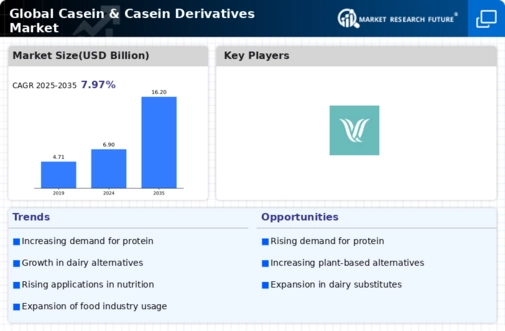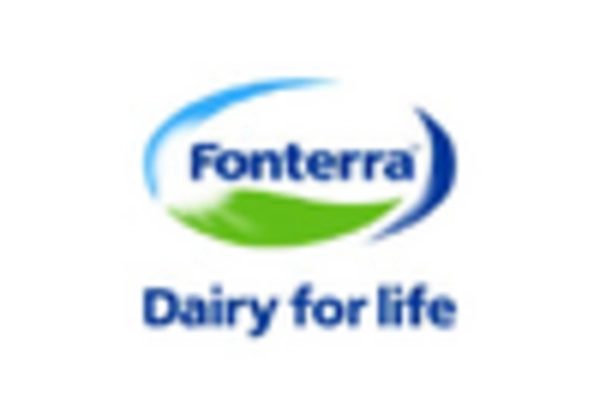-
Executive Summary
-
Scope of the Report
-
Market Definition
-
Scope of the Study
- Research Objectives
- Assumptions &
-
Limitations
-
2.3
-
Market Structure
-
3
-
Market Research Methodology
-
Research Process
-
Secondary Research
-
Primary Research
-
Forecast Model
-
Market Landscape
-
Supply Chain Analysis
- Raw Material Suppliers
- Manufacturers/Producers
- Distributors/Retailers/Wholesalers/E-Commerce
- End Users
-
Porter’s Five
- Bargaining Power of Suppliers
- Threat of Substitutes
- Internal Rivalries
-
Forces Analysis
-
4.2.1
-
Threat of New Entrants
-
4.2.2
-
Bargaining Power of Buyers
-
Market Dynamics of the Global Casein & Casein
-
Derivatives Market
-
5.1
-
Introduction
-
5.2
-
Drivers
-
5.3
-
Restraints
-
5.4
-
Opportunities
-
5.5
-
Challenges
-
6.
-
Global Casein & Casein Derivatives Market, by Type
-
Introduction
-
Casein
- Market Estimates & Forecast, 2023–2032
- Market Estimates
-
& Forecast, by Region, 2023–2032
-
Caseinates
- Market Estimates & Forecast, 2023–2032
- Market Estimates
-
& Forecast, by Region, 2023–2032
-
Casein Hydrolysates
- Market Estimates & Forecast, 2023–2032
- Market Estimates
-
& Forecast, by Region, 2023–2032
-
Others
- Market Estimates & Forecast, 2023–2032
- Market Estimates
-
& Forecast, by Region, 2023–2032
-
Global Casein & Casein Derivatives Market,
-
by Application
-
7.1
-
Introduction
-
7.2
-
Food and Beverages
-
7.2.1
-
Market Estimates & Forecast, 2023–2032
-
7.2.3
-
Dairy Products
-
7.2.3.1
-
Market Estimates & Forecast, by Region,
-
Market Estimates & Forecast, by Region, 2023–2032
-
7.2.5
-
Functional Food & Beverages
-
& Forecast, by Region, 2023–2032
-
& Forecast, by Region, 2023–2032
-
& Forecast, by Region, 2023–2032
-
Dietary Supplements
-
Market Estimates & Forecast, by Region,
-
Market Estimates & Forecast, by Region, 2023–2032
-
Others
-
Market Estimates
-
Industrial
- Market Estimates & Forecast, 2023–2032
- Market Estimates
-
Others
- Market Estimates & Forecast, 2023–2032
- Market Estimates
-
Global Casein & Casein Derivatives Market,
-
by Region
-
8.1
-
Introduction
-
8.2
-
North America
-
8.2.1
-
Market Estimates & Forecast, 2023–2032
-
& Forecast, by Application, 2023–2032
-
& Forecast, by Type, 2023–2032
-
8.2.5
-
Canada
-
8.2.5.1
-
Market Estimates & Forecast, 2023–2032
-
8.2.5.3
-
Market Estimates & Forecast, by Type, 2023–2032
-
Market Estimates
-
US
-
Market Estimates & Forecast, 2023–2032
-
Market Estimates
-
Market Estimates & Forecast, by Application,
-
Market Estimates & Forecast, by Type,
-
Market Estimates & Forecast, by Application, 2023–2032
-
Forecast, 2023–2032
-
& Forecast, by Application, 2023–2032
-
& Forecast, by Type, 2023–2032
-
& Forecast, 2023–2032
-
& Forecast, by Application, 2023–2032
-
& Forecast, by Type, 2023–2032
-
8.3.6
-
Italy
-
8.3.6.1
-
Market Estimates & Forecast, 2023–2032
-
8.3.6.3
-
Mexico
-
Market Estimates &
-
Market Estimates & Forecast, by Type, 2023–2032
-
Market Estimates
-
Europe
- Market Estimates & Forecast, 2023–2032
- Market Estimates
- Market Estimates & Forecast, by Application, 2023–2032
- Germany
- France
-
Market Estimates & Forecast, by Application, 2023–2032
-
Forecast, 2023–2032
-
& Forecast, by Application, 2023–2032
-
& Forecast, by Type, 2023–2032
-
8.3.9
-
Rest of Europe
-
8.3.9.1
-
Market Estimates & Forecast, 2023–2032
-
8.3.9.3
-
Spain
-
Market Estimates &
-
Market Estimates & Forecast, by Type, 2023–2032
-
Market Estimates
-
UK
-
Market Estimates & Forecast, 2023–2032
-
Market Estimates
-
Market Estimates & Forecast, by Application,
-
Market Estimates & Forecast, by Type,
-
Market Estimates & Forecast, by Application, 2023–2032
-
Asia-Pacific
- Market Estimates &
- Market Estimates & Forecast, by Type, 2023–2032
- Market Estimates
- China
-
Forecast, 2023–2032
-
& Forecast, by Application, 2023–2032
-
& Forecast, by Type, 2023–2032
-
8.4.5
-
India
-
8.4.5.1
-
Market Estimates & Forecast, 2023–2032
-
8.4.5.3
-
Market Estimates & Forecast, by Application, 2023–2032
-
Forecast, 2023–2032
-
& Forecast, by Application, 2023–2032
-
Forecast, 2023–2032
-
& Forecast, by Application, 2023–2032
-
& Forecast, by Type, 2023–2032
-
8.5
-
Rest of the World (RoW)
-
Forecast, by Type, 2023–2032
-
& Forecast, 2023–2032
-
& Forecast, by Application, 2023–2032
-
& Forecast, by Type, 2023–2032
-
8.5.6
-
Africa
-
8.5.6.1
-
Market Estimates & Forecast, 2023–2032
-
8.5.6.3
-
Japan
-
Market Estimates &
-
Market Estimates & Forecast, by Type, 2023–2032
-
Market Estimates
-
Australia & New Zealand
-
Market Estimates &
-
Market Estimates & Forecast, by Type, 2023–2032
-
Market Estimates
-
Rest of Asia-Pacific
-
Market Estimates & Forecast, 2023–2032
-
Market Estimates
-
Market Estimates & Forecast, by Application,
-
Market Estimates & Forecast, 2023–2032
-
Market Estimates &
-
Market Estimates & Forecast, by Application, 2023–2032
-
South America
-
Market Estimates
-
Market Estimates & Forecast, by Type, 2023–2032
-
Market Estimates
-
Middle East
-
Market Estimates & Forecast, 2023–2032
-
Market Estimates
-
Market Estimates & Forecast, by Application,
-
Market Estimates & Forecast, by Type,
-
Market Estimates & Forecast, by Application, 2023–2032
-
Company Landscape
-
Introduction
-
Market Strategy
-
Key Development Analysis
-
(Expansions/Mergers &
-
Acquisitions/Joint Ventures/New Product Developments/Agreements/ Investments)
-
Company Profiles
-
American Casein
- Strategy
- Key Developments
- SWOT Analysis
-
Company
-
10.1.1
-
Company Overview
-
10.1.2
-
Financial Updates
-
10.1.3
-
Product/Business Segment Overview
-
Charotar Casein Company
- Company Overview
- Financial Updates
- Product/Business Segment Overview
- Strategy
- Key Developments
- SWOT Analysis
-
Clarion Casein Ltd.
- Company Overview
- Financial Updates
- Product/Business
- Strategy
- Key Developments
- SWOT Analysis
-
Segment Overview
-
10.3.4
-
Strategy
-
10.3.5
-
Key Developments
-
10.3.6
-
SWOT Analysis
-
10.4
-
Royal FrieslandCampina
-
10.4.1
-
Company Overview
-
10.4.2
-
Financial Updates
-
10.4.3
-
Product/Business Segment Overview
-
Westland Milk Products
- Company Overview
- Financial Updates
- Product/Business Segment Overview
- Strategy
- Key Developments
- SWOT Analysis
-
Epi-ingrédients
- Company Overview
- Financial Updates
- Product/Business
- Company Overview
- Financial Updates
- Product/Business Segment Overview
- Strategy
- Key Developments
- SWOT Analysis
-
Segment Overview
-
10.6.4
-
Strategy
-
10.6.5
-
Key Developments
-
10.6.6
-
SWOT Analysis
-
10.7
-
Erie Foods International Inc
-
Kerry Inc.
- Company Overview
- Financial Updates
- Product/Business
- Company Overview
- Financial Updates
- Product/Business Segment Overview
- Strategy
- Key Developments
- SWOT Analysis
-
Segment Overview
-
10.8.4
-
Strategy
-
10.8.5
-
Key Developments
-
10.8.6
-
SWOT Analysis
-
10.9
-
Lactoprot Deutschland GmbH
-
Armor Proteines
- Company Overview
- Financial Updates
- Product/Business
-
Segment Overview
-
10.10.4
-
Strategy
-
10.10.5
-
Key Developments
-
10.10.6
-
SWOT Analysis
-
11.
-
Conclusion
-
LIST
-
OF TABLES
-
Table
-
Global Casein & Casein Derivatives Market, by Region, 2023–2032 (USD
-
Million)
-
Table
-
Global Casein & Casein Derivatives Market, by Type, 2023–2032 (USD Million)
-
Global Casein
-
& Casein Derivatives Market, by Application, 2023–2032 (USD Million)
-
North America:
-
Casein & Casein Derivatives Market, by Country, 2023–2032 (USD Million)
-
North America:
-
Casein & Casein Derivatives Market, by Type, 2023–2032 (USD Million)
-
North America:
-
Casein & Casein Derivatives Market, by Application, 2023–2032 (USD Million)
-
US: Casein &
-
Casein Derivatives Market, by Type, 2023–2032 (USD Million)
-
US: Casein & Casein
-
Derivatives Market, by Application, 2023–2032 (USD Million)
-
Canada: Casein &
-
Casein Derivatives Market, by Type, 2023–2032 (USD Million)
-
Canada: Casein &
-
Casein Derivatives Market, by Application, 2023–2032 (USD Million)
-
Mexico: Casein
-
& Casein Derivatives Market, by Type, 2023–2032 (USD Million)
-
Mexico: Casein
-
& Casein Derivatives Market, by Application, 2023–2032 (USD Million)
-
Europe: Casein
-
& Casein Derivatives Market, by Country, 2023–2032 (USD Million)
-
Europe: Casein
-
& Casein Derivatives Market, by Type, 2023–2032 (USD Million)
-
Europe: Casein
-
& Casein Derivatives Market, by Application, 2023–2032 (USD Million)
-
Germany: Casein
-
& Casein Derivatives Market, by Type, 2023–2032 (USD Million)
-
Germany: Casein
-
& Casein Derivatives Market, by Application, 2023–2032 (USD Million)
-
France: Casein
-
& Casein Derivatives Market, by Type, 2023–2032 (USD Million)
-
France: Casein
-
& Casein Derivatives Market, by Application, 2023–2032 (USD Million)
-
Italy: Casein
-
& Casein Derivatives Market, by Type, 2023–2032 (USD Million)
-
Italy: Casein
-
& Casein Derivatives Market, by Application, 2023–2032 (USD Million)
-
Spain: Casein
-
& Casein Derivatives Market, by Type, 2023–2032 (USD Million)
-
Spain: Casein
-
& Casein Derivatives Market, by Application, 2023–2032 (USD Million)
-
UK: Casein &
-
Casein Derivatives Market, by Type, 2023–2032 (USD Million)
-
UK: Casein & Casein
-
Derivatives Market, by Application, 2023–2032 (USD Million)
-
Rest of Europe: Casein
-
& Casein Derivatives Market, by Type, 2023–2032 (USD Million)
-
Rest of Europe:
-
Casein & Casein Derivatives Market, by Application, 2023–2032 (USD Million)
-
Asia-Pacific:
-
Casein & Casein Derivatives Market, by Country, 2023–2032 (USD Million)
-
Asia-Pacific:
-
Casein & Casein Derivatives Market, by Type, 2023–2032 (USD Million)
-
Asia-Pacific:
-
Casein & Casein Derivatives Market, by Application, 2023–2032 (USD Million)
-
China: Casein
-
& Casein Derivatives Market, by Type, 2023–2032 (USD Million)
-
China: Casein
-
& Casein Derivatives Market, by Application, 2023–2032 (USD Million)
-
India: Casein
-
& Casein Derivatives Market, by Type, 2023–2032 (USD Million)
-
India: Casein
-
& Casein Derivatives Market, by Application, 2023–2032 (USD Million)
-
Japan: Casein
-
& Casein Derivatives Market, by Type, 2023–2032 (USD Million)
-
Japan: Casein
-
& Casein Derivatives Market, by Application, 2023–2032 (USD Million)
-
Australia &
-
New Zealand: Casein & Casein Derivatives Market, by Type, 2023–2032 (USD
-
Million)
-
Table
-
Australia & New Zealand: Casein & Casein Derivatives Market, by Application,
-
Rest of Asia-Pacific: Casein & Casein Derivatives Market,
-
by Type, 2023–2032 (USD Million)
-
Rest of Asia-Pacific: Casein & Casein Derivatives
-
Market, by Application, 2023–2032 (USD Million)
-
Rest of the World (RoW): Casein & Casein
-
Derivatives Market, by Country, 2023–2032 (USD Million)
-
Rest of the World (RoW):
-
Casein & Casein Derivatives Market, by Type, 2023–2032 (USD Million)
-
Rest of the
-
World (RoW): Casein & Casein Derivatives Market, by Application, 2023–2032
-
(USD Million)
-
Table
-
South America: Casein & Casein Derivatives Market, by Type, 2023–2032
-
(USD Million)
-
Table
-
South America: Casein & Casein Derivatives Market, by Application, 2023–2032
-
(USD Million)
-
Table
-
Middle East: Casein & Casein Derivatives Market, by Type, 2023–2032
-
(USD Million)
-
Table
-
Middle East: Casein & Casein Derivatives Market, by Application, 2023–2032
-
(USD Million)
-
Table
-
Africa: Casein & Casein Derivatives Market, by Type, 2023–2032 (USD
-
Million)
-
Table
-
Africa: Casein & Casein Derivatives Market, by Application, 2023–2032
-
(USD Million)
-
LIST OF FIGURES
-
Global Casein & Casein Derivatives Market Segmentation
-
Forecast Research
-
Methodology
-
FIGURE
-
Five Forces Analysis of the Global Casein & Casein Derivatives Market
-
Value Chain
-
of the Global Casein & Casein Derivatives Market
-
Share of the Global Casein & Casein
-
Derivatives Market in 2020, by Country (%)
-
Global Casein & Casein Derivatives Market,
-
by Region, 2023–2032,
-
Global Casein & Casein Derivatives Market Size, by Type,
-
FIGURE
-
Share of the Global Casein & Casein Derivatives Market, by Type, 2023–2032
-
(%)
-
FIGURE
-
Global Casein & Casein Derivatives Market Size, by Application, 2020
-
Share of the
-
Global Casein & Casein Derivatives Market, by Application, 2023–2032 (%)









Leave a Comment